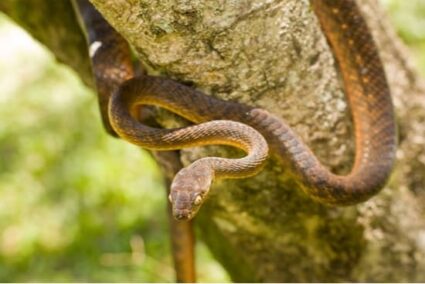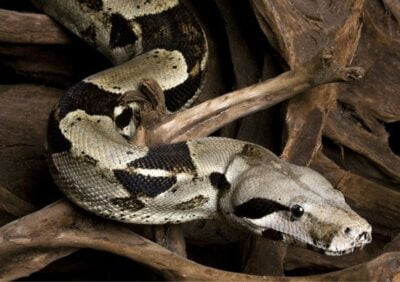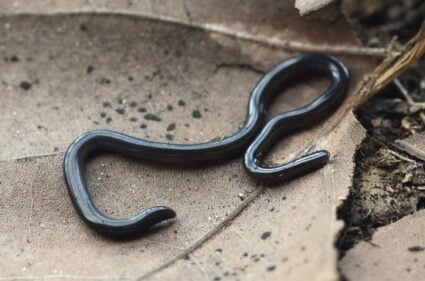Tropical islands, like Hawaii, are typically home to many different snake species. Often, these species of snake are highly venomous and dangerous. However, that’s not the case here.
There are no snake species native to Hawaii. The Hawaiian Islands are physically isolated, so no land snakes have reached it from other landmasses. Exceptions are invasive snakes like boas and corn snakes that people keep illegally as pets. Small numbers of sea snakes have been found around Hawaii, such as the yellow-bellied sea snake.
To ensure that no snakes make it to the Hawaiian Islands, there are laws against keeping them. Shipments are searched for stowaways or illegal imports. But, despite the officials’ best efforts, there are some Hawaiian snakes to be found.
Are There Snakes in Hawaii?
Some snakes live in Hawaii, but not many. The islands were originally devoid of any snakes. But in recent years, some species have been ‘accidentally’ introduced.
However, there’s a big difference between the occasional snake turning up and a breeding population. Any snake found or caught is reported in the local news.
What Snakes are Indigenous to Hawaii?
When Hawaii first developed contact with the wider world, it gained a reputation as a paradise. This is, of course, based in part on the islands’ beautiful vegetation and climate. However, it is also based on the islands’ unique biodiversity.
The animals in Hawaii coexisted for millions of years. Like the dodo, many of them had never been hunted by another animal. They didn’t recognize other animals as threats. This was the case for many animals in Hawaii, too.
There are no indigenous snakes in Maui, or any of the other Hawaiian islands. The word ‘indigenous’ means native to a particular place. To meet that definition, a species has to live there comfortably adjusted to the local climate. This occurs after millions of years of evolution.

There are no snakes in Hawaii that meet this definition. There are a small number of snakes, but these are not considered native. They were only introduced within the last century, either intentionally or unintentionally.
Government officials are eager to prevent snakes from colonizing the island. To ensure that doesn’t happen, they use the law to capture or confiscate any snake that’s found.
Why Are There No Snakes in Hawaii?
In geological terms, the islands of Hawaii are young. The oldest island, Kauai, formed around 5.1 million years ago. Niihau formed 4.9 million years ago, and Oahu formed three and a half million years ago. The other islands formed around the same time.
Animals haven’t had as much chance to reach Hawaii as they have other places. Islands like Great Britain, for example, formed long before Hawaii and used to be connected to other landmasses. This allowed animals to populate the island.
This has never occurred with Hawaii. The islands formed from volcanic eruptions, and have never been connected with any other land. Also, the physical isolation of Hawaii has prevented new animals from getting near.
Other animals found the transition easier. Birds, for example, can fly across the ocean easily. With them (in their droppings) they bring the seeds of new plants. Snakes can’t fly, and most species struggle to swim that far, which makes colonizing islands like these difficult.
But in today’s world, animals can hitch a ride on a ship or a plane to reach new places.
Are There Invasive Snake Species in Hawaii?
While there are no indigenous species, there are invasive snake species in Hawaii. Invasive species are those that are introduced to a new habitat that makes their home there. Examples include Brahminy blind snakes, brown tree snakes, and boa constrictors.
Why Are Invasive Species Not Allowed in Hawaii?
Invasive species affect the habitat they become a part of. They kill off their prey species in large numbers. Their population grows until there isn’t enough prey to support them.
This is compounded by the fact that the species may not have natural predators in that area. Snakes are an excellent example, as few predators eat snakes. Only a select few animals like birds of prey eat snakes, and none of these inhabit Hawaii.
This can have an effect further up the food chain, too, with larger animals struggling to find prey. The invasive species eats them all. If the larger animals can’t eat the snakes instead, they’ll starve. This affects big animals, like eagles, the most.
Are Snakes Illegal in Hawaii?
Bringing snakes into Hawaii, whether as pets or not, is a punishable offense. They are illegal under state law, and the possession and transporting of snakes is a class C felony. You could be fined up to $200,000 and imprisoned for three years.
Any snakes that are found are confiscated. Confiscated snakes end up with the State Department of Agriculture Quarantine Branch, which decides what to do with them. The snakes aren’t euthanized, and are usually kept securely instead.
Despite the harshness of these punishments, people continue to import snakes to Hawaii. There’s no established pet snake trade. So, any that are sold will fetch a higher price than elsewhere in the United States.
And apart from deliberate importations, there are accidental importations too. Snakes can hide in many kinds of shipments, especially from tropical countries. They like to hide in dark, secure places, and shipping containers fit the bill.
Are Pet Snakes Allowed in Hawaii?
Pet snakes of any species are not allowed in Hawaii. Any found are confiscated and kept in quarantine. Between 2000 and 2013, more than 100 snakes were taken by government agents.
It’s because they might be detrimental to the environment. Hawaii is home to many unique species of small birds and mammals. Many of them aren’t preyed on by any other animal on the islands.
A snake could make these species extinct. Also, there’s no natural predator of snakes in Hawaii, so their population would keep expanding until there’s no prey left. That’s why authorities made importing or owning snakes in Hawaii against the law.

Are All Snakes Confiscated in Hawaii?
If anybody is found to possess a snake, it is confiscated and the person punished. However, state officials realize that the punishment for keeping snakes is severe, although justified. They rely on an amnesty system.
Under this system, any snake owner—or anybody who finds a snake—is free to pass it on to officials with no questions asked. No punishments are handed down if the snake is handed in by its owner.
It’s the Hawaii State Department of Agriculture that runs this program. But snakes can also be handed to the Honolulu Zoo, Panaewa Zoo, or any branch of the Humane Society.
People are also encouraged to call a toll-free ‘pest hotline,’ 643-PEST, to report illegal animals of any kind. While this may seem drastic, the damage that snakes could do to Hawaii’s unique habitats would be immeasurable.
Which Snakes Live in Hawaii?
Despite the best efforts of government officials, some snakes do make it into the state. The sheer number of tourists, plus shipments delivered from around the world, guarantee it.
Because there is no recognized snake trade in Hawaii, specimens fetch higher prices. This encourages people to smuggle them into the state illegally. Pet snakes may make it into the wild.
Brahminy Blind Snake (Ramphotyphlops Braminus)
Of the invasive snake species in Hawaii, the most common are Brahminy blind snakes. These are tiny snakes that look like earthworms. They’re brown, and much longer than they are wide. Their head is the same width as their tail.
Like earthworms, these snakes live in soil—hence their nickname, the flowerpot snake. But they are a different texture to earthworms. Their scales are solid like those of other snakes, not soft and slimy like earthworms.
They’re the smallest snake species (on average) found in North America. Some think that they were introduced to Hawaii accidentally in a shipment of plants.
Others think they arrived in a shipment of potting soil from the Philippines at some time in the 20th century, between the 1930s and 1980s.
Something unique about these snakes is that they’re all female. They’re the only known ‘parthenogenic’ snake. This is where a female can develop an egg without it being fertilized by a male.
This means that every Brahminy blind snake is, essentially, a clone. It would also explain how one specimen in a flowerpot could go on to produce the population of a whole island. Either way, these tiny snakes now live in the soil of Hawaii’s islands.
That being said, these snakes aren’t an issue. They feed on ants, termites and their larvae, which are resilient and can survive the introduction of an extra predator. They don’t bite people.

Brown Tree Snakes (Boiga Irregularis)
Brown tree snakes are a kind of constrictor that lives in trees. They vary from yellow to a deep reddish-brown. Because they live in trees (arboreal), they eat birds and birds’ eggs. They aren’t a danger to people, but they are a danger to wildlife.
Brown tree snakes are a well-known invasive snake. They have successfully colonized several northern Pacific islands. They were originally found only in the south Pacific: Australia, Papua New Guinea and the various islands in between.
However, shortly after World War II, the snakes were accidentally transported to Guam by a cargo ship or aircraft. Here the snake was successful, due to the abundant prey available. Sometime between then and now, the snakes may have been transported to Hawaii.
They may have stowed away in U.S. military aircraft. These frequently travel between the two islands. They aren’t known to be established on the island, but there may be isolated population pockets. Officials aren’t sure.
Whatever the case, local officials are highly concerned at the presence of these snakes. After their destruction of the wildlife of Guam, they could potentially ruin the uniquely preserved ecosystem of Hawaii’s islands.
Steps are being taken to ensure that any snakes are caught and killed. According to Hawaii News Now, four sterile specimens have been brought to the island for use by the police.
Officers will teach dogs to track their scent, so those wild specimens can be captured and dealt with before they cause more damage.
Boa Constrictors
There is no evidence that boa constrictors breed in the wild in Hawaii. However, there is evidence that there are some out there. Stories of boa constrictors being found, or even run over, are in the Hawaiian news.
If they were to breed in the wild, boa constrictors would be bad news for Hawaii’s wildlife. In the wild, they feed on birds, and many of Hawaii’s unique bird species are already endangered. The warm rainforests of Hawaii would also be ideal for them.
However, there is no evidence that this has happened as of yet. It’s more likely that the specimens that are found were once pets. Some of the boas are unique morphs, which means that’s the case.
Are There Pet Snakes Loose in Hawaii?
Aside from these examples, evidence of snakes is thin on the ground. No breeding populations of any snake have been discovered. Brahminy blind snakes are endemic, but these don’t significantly alter the biodiversity of the Hawaiian Islands.
However, there are frequent examples of snakes escaping from captivity. These are usually common pet snakes such as:
- Corn snakes, like this one reported by Big Island News.
- Ball pythons, like this one reported by the Star Advertiser. It was found in on a road in Hilo.
- Garter snakes, like this one reported by KITV Island News.
These snakes are let loose by their owners. That could be when the person can’t afford them anymore. Or, they may want to get rid of their snake as they’re tired of it. Letting them free is highly irresponsible because of the damage it could cause.
Or, the snake could have gotten loose without the owner’s knowledge. The fact that this can happen shows why it would be dangerous to allow legal snake ownership in Hawaii.
Sea Snakes in Hawaii
Land snakes may be of special concern in Hawaii, but sea snakes aren’t discussed as much. There are no native sea snakes around Hawaii, due to its isolation. However, that doesn’t mean that the Hawaiian Islands don’t get occasional visitors.
Yellow-Bellied Sea Snake (Pelamis Platurus)
The yellow-bellied sea snake has one of the widest ranges of any snake in the world. You can find it anywhere from the Pacific Central American coast, around most Pacific islands from Hawaii to Australia, and further west still all the way to the east coast of Africa and Saudi Arabia.
These snakes are long and thin, and can swim long distances. They reach around 30-35 inches in length. But it’s their venom that makes them interesting. Like other sea snakes, their venom is potent.
When one bites you, its venom causes damage to skeletal muscle. This causes myoglobinuria, which is where broken down muscle tissue is excreted through urine. If it uses enough venom, you may experience paralysis and severe kidney damage.
That being said, these snakes are not common around Hawaii. They are typically found further south. They can swim long distances across the open ocean, but they prefer to stay near islands to hunt. Hawaii’s isolation means the snakes rarely visit.
Only around twenty encounters have been recorded in Hawaiian waters.
Other Sea Snakes
Yellow-bellied sea snakes aren’t the only snake you can find in Pacific waters. You will also find the following sea snakes:
- Blue-lipped sea kraits
- Yellow-lipped sea kraits
- Black-banded sea kraits
However, you won’t find these snakes around Hawaii. Only the yellow-bellied sea snake is comfortable swimming in the open ocean. All other sea snakes prefer to stay near the shore, in coral reefs, of which there are many.
That’s because it’s easier to hunt there. The snakes can corner their prey up against the coral. In the open ocean, it’s impossible for them to hunt effectively.
Only yellow-bellied sea snakes can hunt in the open ocean. They do so by sitting motionless on the surface and waiting to ambush small fish. This enables them to swim out further than other sea snake species can.
Whatever the case, even yellow-bellied sea snakes around Hawaii only visit rarely. And authorities will be happy that no breeding colonies of snake species (apart from bling snakes) have yet been found. But that could all change in the future.


I saw a Black-banded sea krait in front of the Hilton in Wakiki. I was so scared because it swam right between my legs. This snake was about 7 to 8 feet long swimming along the open sand.